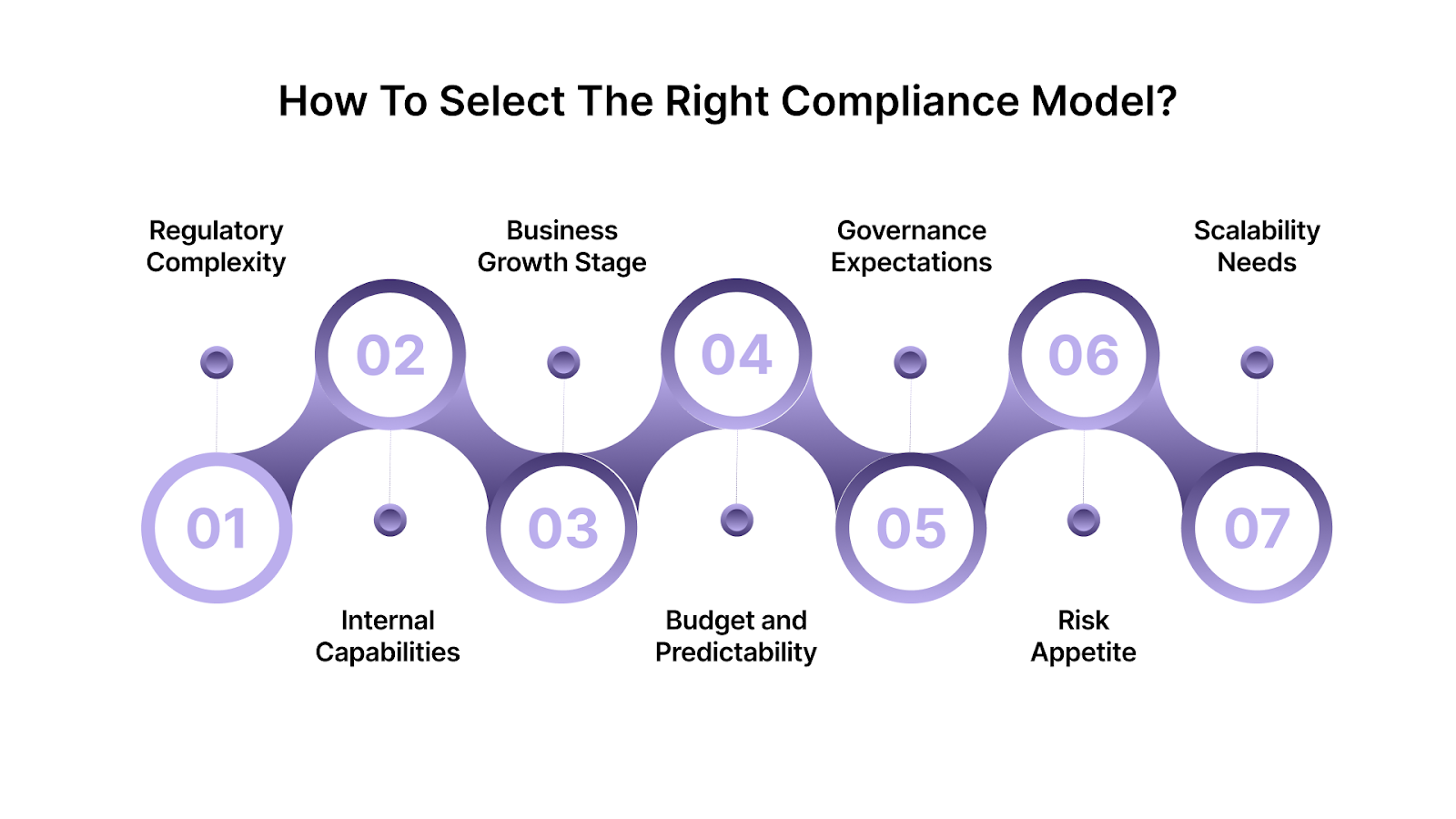Nov 14, 2025
Outsourced Compliance 2025: NextFractional vs Fraxtional

By Fraxtional LLC

Over 93% of fintech companies struggle to meet compliance requirements, exposing the scale of regulatory pressure across financial sectors. Compliance failures delay growth, limit funding, and raise investor concerns about accountability and operational control.
For executives and investors, the issue isn’t awareness but bandwidth. Managing multiple regulators and complex jurisdictions without consistent oversight often leads to missed filings, costly delays, and reputational risk.
In this blog, we’ll explore outsourced and fractional compliance models, their key differences, and how each can help businesses maintain credibility, control costs, and strengthen investor confidence.
TL;DR
- Compliance as a Core Growth Function: Investors treat compliance as a strategic pillar, not a checkbox, influencing funding decisions and long-term partnerships.
- Different Models, Different Outcomes: Outsourced compliance handles daily operations, while fractional compliance provides leadership and strategic oversight.
- Decision Based on Risk and Reach: The right model depends on how fast your business is expanding and how much regulatory control you need internally.
- Choosing Requires Context: The right approach depends on regulatory reach, internal capability, growth stage, and the level of oversight investors expect.
- Investor Confidence Starts with Expertise: Engaging specialized fractional compliance experts helps companies demonstrate preparedness, transparency, and accountability.
What Is Outsourced Compliance?

Outsourced compliance refers to delegating daily compliance operations to an external provider that manages regulatory tasks on behalf of the company. This model suits firms seeking consistency, accuracy, and lower overhead without maintaining a full in-house compliance department.
Outsourced compliance teams usually handle essential functions that keep operations aligned with regulatory expectations, including:
- Regulatory Reporting: Preparing and submitting required filings to financial authorities with minimal disruption to internal teams.
- AML and KYC Monitoring: Conducting continuous checks on clients and transactions to meet anti-money laundering standards.
- Policy and Procedure Maintenance: Updating compliance manuals and operational checklists to reflect current regulations.
- Licensing Support: Assisting with applications, renewals, and cross-border regulatory filings.
- Audit Preparation: Organizing internal reviews and documentation to ensure readiness for external audits.
- Training and Awareness: Providing structured programs to help staff understand compliance obligations and reduce internal risk.
While outsourced compliance supports day-to-day operations, some organizations require leadership that drives strategy; that’s where fractional compliance fits in.
Also Read: KYC Compliance in Commercial Banking Explained
What Is Fractional Compliance?

Fractional compliance involves hiring a senior compliance professional or team on a part-time or project basis to guide strategy and oversight. This approach focuses on leadership, risk assessment, and long-term compliance planning rather than routine task management.
Fractional compliance professionals typically provide high-level support, such as:
- Strategic Oversight: Designing and directing compliance frameworks that align with business goals and investor expectations.
- Regulatory Advisory: Interpreting complex laws across multiple jurisdictions and advising executives on operational impact.
- Risk Assessment: Evaluating exposure areas, control weaknesses, and potential regulatory triggers before they escalate.
- Governance Support: Acting as an interim Chief Compliance Officer or senior advisor to boards and investors.
- Market Entry Guidance: Advising companies entering new regions or product categories with varying regulatory standards.
- Compliance Roadmaps: Developing long-term strategies that evolve with business growth, investor scrutiny, and jurisdictional expansion.
Now that you understand both models individually, comparing them side by side will clarify which structure suits your growth and regulatory goals.
Hire Fraxtional Leadership in North America and Beyond!
Comparing Outsourced and Fractional Compliance: Which Is Right for You?
Both models address compliance needs but differ in scope, control, and strategic intent. Outsourced compliance focuses on task execution, while fractional compliance emphasizes leadership and advisory functions at an executive level.
The comparison below highlights how each model supports business objectives, cost control, and investor expectations:
Once you’ve compared both approaches, the next question is how to decide which model aligns with your risk tolerance and growth plan.
Also Read: How Fractional CROs Are Changing Regulatory Compliance
Choosing the Right Compliance Model for Your Business
Choosing between outsourced and fractional compliance depends on your organization’s size, growth stage, and the complexity of its regulatory footprint. The right model aligns with your resources, governance needs, and investor expectations.
Key factors to evaluate before making a decision include:

- Regulatory Complexity: Assess how many jurisdictions your business operates in and the variability of those regulations.
- Internal Capabilities: Determine whether your existing team can manage compliance independently or requires ongoing external structure.
- Business Growth Stage: Identify if your organization is maintaining steady operations or expanding into new markets requiring deeper oversight.
- Budget and Predictability: Compare fixed service costs versus flexible advisory retainers to maintain financial control.
- Governance Expectations: Consider investor requirements for board-level visibility, transparency, and senior compliance leadership.
- Risk Appetite: Evaluate how much risk exposure your organization can accept and how proactive your compliance posture should be.
- Scalability Needs: Decide whether your compliance setup should remain operational or evolve into strategic governance as you grow.
After identifying your ideal compliance structure, it’s time to look at the leading providers delivering these models in practice.
Also Read: When to Hire a Fractional Compliance Officer
NextFractional vs Fraxtional for Outsourced Compliance
When comparing fractional service providers, specialization makes the difference. NextFractional offers general executive support across marketing, finance, and operations, while Fraxtional focuses exclusively on compliance and regulatory leadership.
Generalist firms may provide flexibility, but financial institutions need precision. Fraxtional centers its services on compliance strategy, risk control, and licensing support, embedding leadership that drives accountability and investor assurance.
The table below outlines these key differences:
Fraxtional brings focus, credibility, and regulatory depth. For financial and investment-driven firms, this focus directly supports growth and investor confidence.
Conclusion
The market is crowded with broad fractional networks, but growth-stage FinTech and Crypto firms require compliance leadership that is focused, proven, and immediate. Searching through generalist talent pools delays decisions that directly affect regulatory standing and investor confidence.
Fraxtional removes that uncertainty by connecting businesses with experienced C-suite compliance and risk executives who deliver clarity from day one. Whether securing SOC 2 certification or achieving sponsor bank approval, we match you with leaders built for high-stakes compliance demands.
Contact Fraxtional today to receive a tailored compliance profile for your specific regulatory challenge.
FAQs
Consulting typically involves external experts providing advice or recommendations on a specific issue, often on a project basis. Fractional roles, in contrast, embed senior professionals within the organization, giving them decision-making authority and accountability similar to an internal executive.
A contract role usually focuses on executing defined tasks or deliverables with limited strategic responsibility. A fractional role involves leadership engagement, guiding strategy, managing teams, and influencing long-term outcomes without being a full-time employee.
Yes. Many organizations pair outsourced teams for daily compliance operations with fractional executives who oversee regulatory strategy, ensuring a balance between execution and accountability.
Most fractional compliance leaders can integrate within a few weeks, depending on regulatory complexity, existing systems, and documentation readiness. Their experience often allows them to identify immediate priorities and establish structure rapidly.
Investors often suggest a fractional model when a portfolio company faces upcoming audits, expansion into new jurisdictions, or increased regulatory scrutiny, circumstances requiring experienced oversight without full-time hiring costs.
blogs
Don’t miss these
Let’s Get Started
Ready to Strengthen Your Compliance Program?
Take the next step towards expert compliance solutions. Connect with us today.




